Featured Book: The Shape of Things
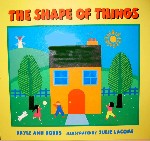
The Shape of Things by Dayle Ann Dodds introduces the geometric shapes as they are found in the world around us. Students will be challenged to locate all of the triangles in the illustration or the squares, etc. Shape patterns form the border of each page, prompting more discussion about shapes, color and size.
- Students can create their own shape pages for a class book on "The Shape of Things." Download the
 Shape of Things template so that students can choose a shape, draw a picture, stamp the border and add their own words to the page prompt.
Shape of Things template so that students can choose a shape, draw a picture, stamp the border and add their own words to the page prompt.
Geometry
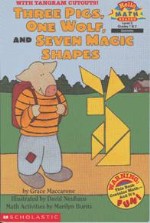
Three Pigs, One Wolf and Seven Magic Shapes
Three Pigs, One Wolf and Seven Magic Shapes by Grace Maccarone is a mathematical take on the classic fairy tale. Students are introduced to tangrams in this leveled reader. The pigs use the seven magic shapes to form solutions to the problems they encounter. Students will enjoy using tangrams to recreate the figures in the book as well as creating their own tangram figures for classmates to solve.
- Download the
 Seven Magic Shapes Templates that show individual pieces so that young students can position tangram pieces correctly to form the characters in the book. These templates were designed to be used with commercial tangram pieces.
Seven Magic Shapes Templates that show individual pieces so that young students can position tangram pieces correctly to form the characters in the book. These templates were designed to be used with commercial tangram pieces.
- Download the
 Seven Magic Shapes Shadow Templates that show black shapes so that students must figure out how to position tangram pieces correctly to form the characters in the book. These templates were designed to be used with commercial tangram pieces.
Seven Magic Shapes Shadow Templates that show black shapes so that students must figure out how to position tangram pieces correctly to form the characters in the book. These templates were designed to be used with commercial tangram pieces.
- Download the
 Tangram Shapes Template can be used to create tangram pieces to use with templates above if commercial tangram pieces are not available.
Tangram Shapes Template can be used to create tangram pieces to use with templates above if commercial tangram pieces are not available.
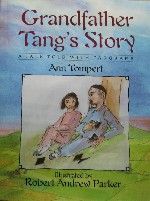
Grandfather Tang's Story
Grandfather Tang's Story by Anne Tompert also uses tangrams to illustrate the story a grandfather tells his granddaughter. Students will enjoy recreating the tangram creatures found throughout the book.
- Assemble the tangram pieces to replicate figures in the book. Trace around the outside of the figures then fill in the shape with black marker. These are best traced onto oaktag or card stock and laminated before use. Place the tangram characters and tangram pieces in your math center for students to try during center time.
- Ask students to create a new character for the book and make a tangram mat for the character that can be added to the tangram center for classmates to try.
Measurement

The Biggest Pumpkin Ever
The Biggest Pumpkin Ever by Stephen Kroll would be a great literature connection for the Huge Pumpkin Estimation Station discussed above or to introduce the class pumpkin sorting activity.
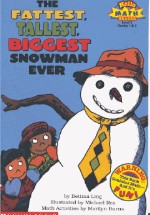
The Fattest, Tallest, Biggest Snowman Ever
The Fattest, Tallest, Biggest Snowman Ever by Bettina Ling is a Level 2 Hello Math Reader (Gr. 1-2) that introduces students to the concept of measuring objects using nonstandard units and instruments. When neither child's arms are long enough to measure around the snowmen to see whose snowman is biggest, they decide to use a string of paper clips to measure.
- The book also provides suggestions for follow-up measurement activities such as the String-a-Long Game in which students look at (but don't touch) ordinary, everyday objects, then cut a piece of string they think is the same length as the object. Students compare their strings to the object to see whose string is closest to the length. Consider using the "String-a-Long Game" as a great measurement center activity.
- Paper-clip chains: Have students measure classroom objects using paper-clip chains. Be sure to ask students to estimate first, then measure. Students will begin to develop an "eye for distances."
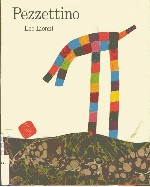
Pezzettino
Pezzettino by Leo Lionni is a great introduction to the concept of area as how many small squares cover a surface.
- After reading the book, have students use color tiles or paper squares to first estimate how many squares will cover an object then actually use the squares to measure the object.
- Students can also create their own Pezzettino characters using colored construction paper squares. The class discussion should focus on comparing the "sizes" of these Pezzettino characters based on their area or the number of squares used to construct each character. Download the
 Pezzettino Characters handout and squares template. The squares template can be used to copy squares onto construction paper that has been trimmed to 8.5 x 11 inch size to use in a copier. Ellison pattern block square cutouts will also produce small squares from construction paper.
Pezzettino Characters handout and squares template. The squares template can be used to copy squares onto construction paper that has been trimmed to 8.5 x 11 inch size to use in a copier. Ellison pattern block square cutouts will also produce small squares from construction paper.

Bats Around the Clock
Bats Around the Clock by Kathi Appelt takes a humorous dance through time. Click Dark and American Batstand introduce a new dance each hour. Students move through time, enjoy some rhyme and learn the names of some oldie-but-goodie dances along the way.

Just a Minute
Just a Minute by Teddy Slater is a humorous look at how easily adults tell kids to wait "just a minute." The young boy in the story waits much longer than a minute for his parents but he soon learns that he can't use the same line back to them.
- How long is a minute? Start timing and challenge students to stand when they think a minute has passed.
- What Can We Do in a Minute? Ask students to think of different things they could do many times in a minute, then actually work in pairs to do the activity and count how many times they can do it in a minute. Some students have suggested: blink eyes, do jumping jacks, count aloud, etc. Make a class booklet of suggestions and actual measurements.
